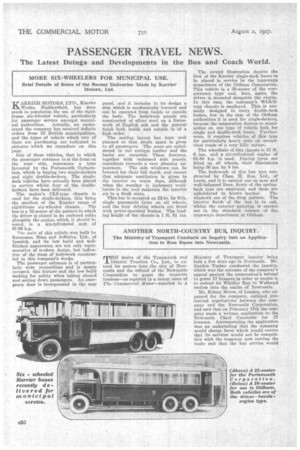PASSENGER TRAVEL NEWS.
Page 58

If you've noticed an error in this article please click here to report it so we can fix it.
The Latest Doings and Developments in the Bus and Coach World.
MORE SIX-WHEELERS FOR MUNICIPAL USE.
Brief Details of Some of the Recent Deliveries Made by Karrier Motors, Ltd.
KARRIER MOTORS, LTD., Karrier Works, Huddersfield, has done much to popularize the use of the rigidframe six-wheeled vehicle, particularly for passenger service amongst munici pal authorities. Actually, we understand the company has received definite orders from 12 British municipalities, and the types of vehicle which two of them are purchasing are indicated in pictures which we reproduce on this page.
One of these vehicles, that in which the passenger entrance is at the front on the near side, represents a type favoured by the Portsmouth Corporation, which is buying two single-deckers and eight double-deckers. The singledeck vehicles have actually been placed in service whilst four of the doubledeckers have been delivered.
The maker's CL6-type chassis is used for the single-deckers, this being the smallest of the Karrier range of rigid-frame six-wheeled chassis. The bus is a 32-seater of the pattern in whiCh the driver is placed in gn enclosed cabin alongside the engine, which, it should be noted, is a six-cylindered unit of 47-56 h.p.
'rbe uody of this vehicle was built by Ransornes, Sims and Jefferies. Ltd., of Ipswich, and its low build and wellfinished appearance are not only representative of modern design, but indicative of the class of bodywork constructed in this company's works.
The passenger entrance is of particularly wide proportions and is deeply recessed, this feature and the low build making for safety when taking aboard and setting down passengers. An emergency door is incorporated in the rear panel, and it includes in its design a step which is mechanically lowered and can be operated from inside or outside the body. The bodywork panels are constructed of silver steel on a framework of English ash and the general finish both inside and outside is of a high order.
The seating layout has been well planned so that ample space is given to all passengers. The seats are upholstered in red antique leather and the backs are carpeted. These features, together with embossed side panels, contribute towards a very pleasing appearance. The side windows can be lowered for their full depth, and ensure that adequate ventilation is given to the interior on warm days, although when the weather is inclement ventilators in the roof maintain the interior air in a fresh state.
This bus is mounted on 32-in. by 6-in. single pneumatic tyres on all wheels, and the four driving wheels are fitted with power-operated brakes. The loading height of the chassis is 1 ft. SA ins. The second illustration depicts the first of the Karrier single-deck buses to be placed in service by the tramways department of the Oldham Corporation. This vehicle is a 39-seater of the rearentrance type and, here, again, the driver is mounted alongside the engine. In this case, the company's WL6/2type chassis is employed. This is normally designed to carry double-deck bodies, but in the case of the Oldham authorities it is used for single-deckers, because the corporation desires to standardize on one type of vehicle both for single and double-deck buses. Furthermore, it requires vehicles r:kf this type for particularly heavy duty on secondclass roads of a very hilly nature.
The wheelba'se of this chassis is 17 ft. 6 ins., and a six-cylindered engine of 61-80 h.p. is used. Dunlop tyres are fitted on all wheels, their dimensions being 36 ins. iv 8 ins.
The bodywork of this bus was constructed by Chas. H. Roe, Ltd., of Leeds, and it is carried out on neat and well-balanced lines. Seats of the springback type are employed, and these are upholstered in brown leather. The windowS are of the drop pattern. The interior finish of the bus is in oak, whilst the exterior painting . is carried out in the standard colours of the tramways department at Oldham.












































































































